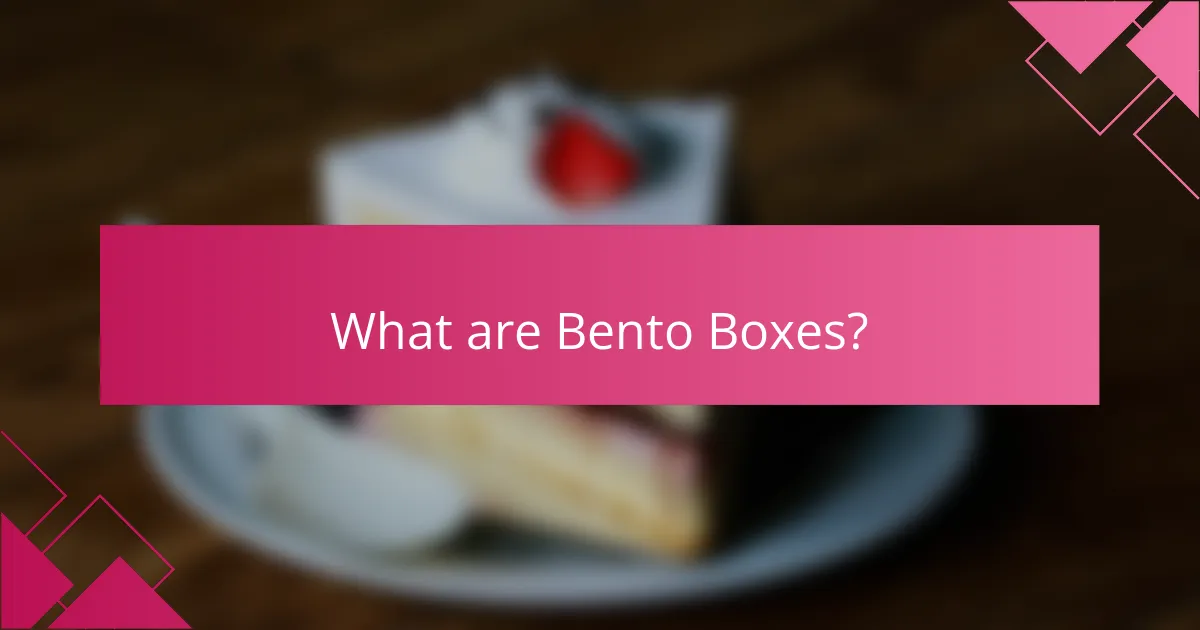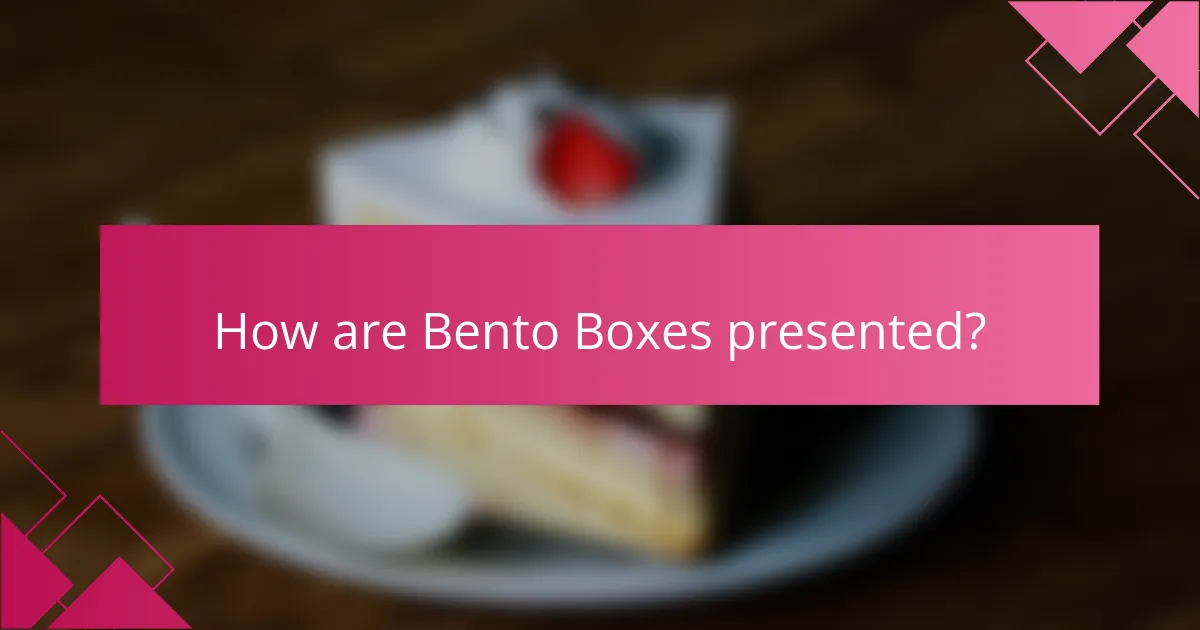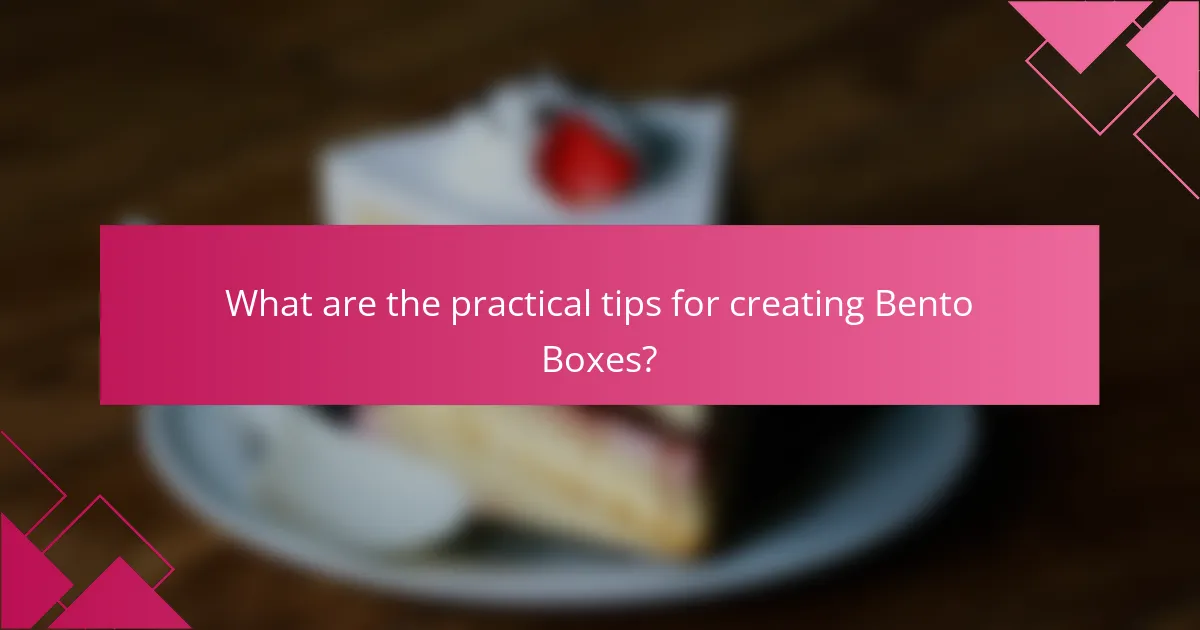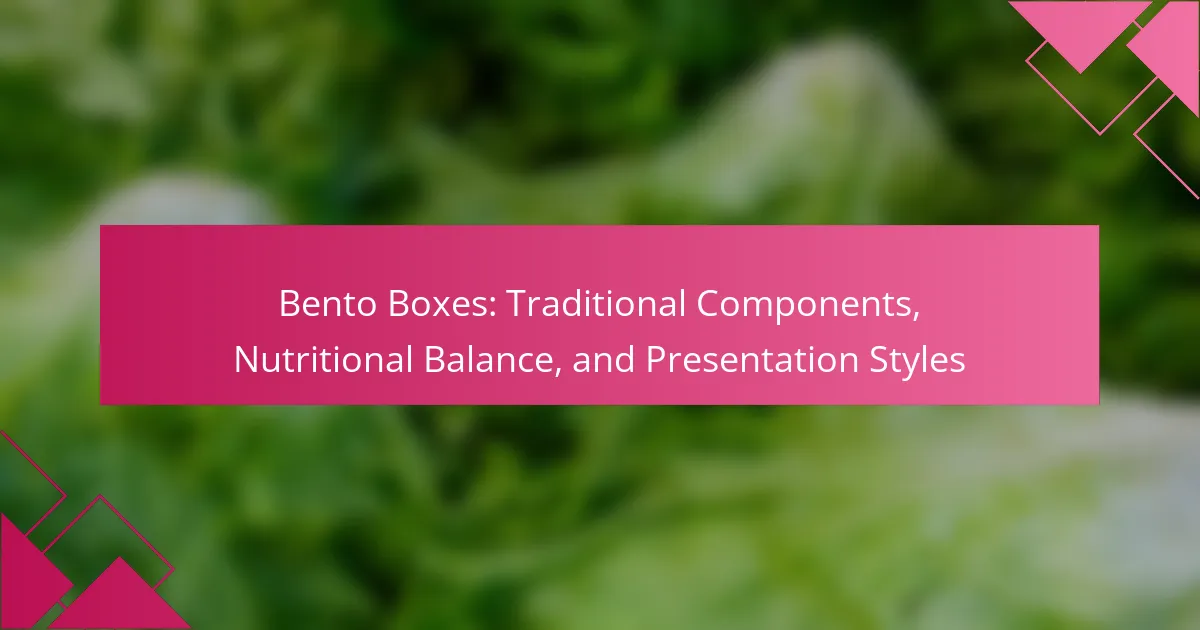
What are Bento Boxes?
Bento boxes are traditional Japanese lunch boxes that contain a variety of food items. They typically feature a balanced meal with portions of rice, protein, and vegetables. Bento boxes are designed for convenience and portion control. They are often compartmentalized to separate different food items. The presentation of bento boxes is considered an art form in Japan. Colorful ingredients are arranged aesthetically to enhance visual appeal. Bento boxes can be homemade or purchased from restaurants. They promote healthy eating habits by offering a variety of nutrients in one meal.
How did Bento Boxes originate?
Bento boxes originated in Japan during the Kamakura period (1185-1333). Initially, they were simple wooden containers used by travelers for meals. Over time, their design evolved to include compartments for various food items. The practice of packing meals into bento boxes became popular among farmers and laborers during the Edo period (1603-1868). These meals were convenient and portable, catering to the needs of busy individuals. By the late 19th century, bento boxes were commonly seen in schools and during festivals. Today, they are celebrated for their aesthetic appeal and nutritional balance in Japanese cuisine.
What historical significance do Bento Boxes hold in Japanese culture?
Bento boxes hold significant historical importance in Japanese culture as they represent a practical and aesthetic approach to meal preparation. Originating during the Kamakura period (1185-1333), these boxes were initially used for transporting meals during travel. The design evolved through the Edo period (1603-1868), where they became popular among the samurai class. Bento boxes symbolized not only nourishment but also social status and artistry in food presentation. The intricate designs and balanced meals reflected the cultural values of harmony and beauty in Japanese cuisine. Today, bento boxes continue to be a staple in Japanese life, showcasing both tradition and modern culinary practices.
How have Bento Boxes evolved over time?
Bento boxes have evolved significantly from their origins in Japan. Initially, they were simple wooden containers used for rice and side dishes. Over time, the design became more intricate, incorporating various compartments for diverse food items. By the Edo period, bento boxes included seasonal ingredients and artistic presentation. The introduction of plastic in the 20th century made bento boxes more accessible and affordable. Today, bento boxes come in various materials, including stainless steel and silicone. Modern bento emphasizes nutritional balance and aesthetic appeal, often featuring colorful and creatively arranged food. This evolution reflects changing dietary habits and cultural influences globally.
What are the traditional components of a Bento Box?
A traditional Bento Box typically consists of rice, protein, and various side dishes. Rice serves as the main staple in Japanese cuisine, often shaped into balls or pressed into containers. Protein options include grilled fish, chicken, or tofu, providing essential nutrients. Side dishes often feature pickled vegetables, seasonal vegetables, and sometimes fruit. These components create a balanced meal in terms of nutrition and flavor. A well-prepared Bento Box emphasizes variety and color, enhancing visual appeal. Each element is carefully selected to offer a harmonious blend of taste and nutrition.
What types of food are typically included in a traditional Bento Box?
A traditional Bento Box typically includes rice, fish or meat, pickled vegetables, and seasonal fruits. Rice serves as the main carbohydrate source. Fish or meat provides essential protein. Pickled vegetables add flavor and balance. Seasonal fruits offer a sweet finish. This variety reflects Japanese culinary principles of balance and presentation. Each component is carefully arranged for visual appeal. The combination promotes nutritional diversity and portion control.
How are the ingredients chosen for a balanced Bento Box?
Ingredients for a balanced Bento Box are chosen based on nutritional variety and visual appeal. Each Bento Box typically includes a protein source, vegetables, carbohydrates, and fruits. Proteins may include fish, chicken, or tofu, providing essential amino acids. Vegetables are often colorful and include options like broccoli, carrots, or pickled items for vitamins and minerals. Carbohydrates usually come from rice or noodles, supplying energy. Fruits add natural sweetness and additional nutrients. The selection aims for a balance of flavors, textures, and colors, enhancing both nutrition and presentation. This method aligns with traditional Japanese dietary guidelines, promoting health and well-being.
Why is nutritional balance important in Bento Boxes?
Nutritional balance in Bento Boxes is crucial for promoting overall health. It ensures that individuals receive a variety of essential nutrients. A well-balanced Bento Box typically includes proteins, carbohydrates, fats, vitamins, and minerals. This diversity supports bodily functions and energy levels. Studies show that balanced meals can improve cognitive performance and mood. Furthermore, nutritional balance helps in weight management and reduces the risk of chronic diseases. For instance, incorporating vegetables can provide fiber and antioxidants. Overall, nutritional balance contributes to a healthier lifestyle and well-being.
What are the key nutritional components to consider?
Key nutritional components to consider in bento boxes include carbohydrates, proteins, fats, vitamins, and minerals. Carbohydrates provide energy and are often sourced from rice or grains in bento boxes. Proteins are essential for muscle repair and growth, typically included through meats, tofu, or legumes. Fats are important for hormone production and energy, usually derived from nuts or oils. Vitamins and minerals support various bodily functions and are abundant in vegetables and fruits included in the box. A balanced bento box incorporates these components to ensure nutritional adequacy. This balance aligns with dietary guidelines that recommend a variety of food groups for optimal health.
How can one achieve a balanced nutritional profile in a Bento Box?
To achieve a balanced nutritional profile in a Bento Box, include a variety of food groups. Incorporate proteins such as grilled chicken or tofu for essential amino acids. Add whole grains like brown rice or quinoa for complex carbohydrates. Include a colorful array of vegetables to provide vitamins and minerals. Incorporate healthy fats from sources like avocado or nuts for heart health. Aim for a balance of macronutrients: carbohydrates, proteins, and fats. Portion sizes should be appropriate for dietary needs and preferences. This approach ensures a diverse nutrient intake. Research shows that varied diets support overall health and well-being.

How are Bento Boxes presented?
Bento boxes are presented in a visually appealing and organized manner. They typically feature a variety of food items arranged in separate compartments. Each compartment often contains different types of food, such as rice, vegetables, and protein. This separation helps maintain the integrity of each dish’s flavor and texture. The presentation emphasizes color contrast and balance, making the meal visually attractive. Traditional bento boxes may also include decorative elements, such as garnishes or edible flowers. The overall arrangement is designed to create a harmonious and appetizing meal experience.
What are the different presentation styles for Bento Boxes?
The different presentation styles for Bento Boxes include traditional, modern, and artistic styles. Traditional Bento Boxes emphasize simplicity and balance, often featuring rice, protein, and vegetables in separate compartments. Modern styles may incorporate fusion elements and vibrant colors, appealing to contemporary tastes. Artistic presentation focuses on aesthetic appeal, using intricate designs and shapes to create visually stunning arrangements. Each style serves to enhance the dining experience while maintaining the core principles of Bento Box design.
How does the presentation affect the perception of the meal?
Presentation significantly affects the perception of a meal. A visually appealing presentation enhances the dining experience and stimulates appetite. Research shows that people often judge the taste of food based on its appearance. For instance, neatly arranged ingredients in a bento box can create a sense of harmony and balance. This arrangement can lead to higher expectations regarding flavor and quality. Studies indicate that colorful and well-proportioned meals are perceived as more delicious. The psychology of food presentation suggests that aesthetics can influence satisfaction and enjoyment. Therefore, the way a meal is presented directly impacts how it is perceived by diners.
What cultural influences shape the presentation of Bento Boxes?
Cultural influences that shape the presentation of Bento Boxes include Japanese aesthetics, seasonal ingredients, and regional customs. The concept of ‘wabi-sabi’ emphasizes simplicity and beauty in imperfection. Seasonal ingredients reflect the Japanese appreciation for nature and its cycles. Regional customs dictate variations in presentation styles, with each area showcasing local specialties. Additionally, the influence of art forms like ‘kawaii’ encourages playful and visually appealing arrangements. These elements collectively contribute to the unique and culturally rich presentation of Bento Boxes.
What are the common themes in Bento Box presentation?
Common themes in Bento Box presentation include visual appeal, balance of colors, and portion control. The visual appeal is achieved through the careful arrangement of food items. This arrangement often reflects seasonal themes or cultural motifs. Balance of colors enhances the aesthetic, making the meal more inviting. Portion control ensures that each item is served in appropriate amounts. Additionally, the use of garnishes adds texture and variety. These themes contribute to the overall experience of enjoying a Bento Box.
How does color play a role in Bento Box aesthetics?
Color significantly influences Bento Box aesthetics. It enhances visual appeal and creates a balanced presentation. A variety of colors represents different food groups. This variety can indicate nutritional balance, making the meal more inviting. For example, vibrant greens from vegetables contrast with rich reds from proteins. Studies show that colorful meals can stimulate appetite and improve perception of taste. Additionally, color combinations can reflect cultural significance and seasonal themes. Overall, color is essential for creating an appealing and nutritious Bento Box.
What techniques can enhance visual appeal in Bento Box design?
Techniques that can enhance visual appeal in Bento Box design include color contrast, arrangement, and garnishing. Utilizing a variety of colors creates an eye-catching presentation. Arranging food in a balanced manner helps to create symmetry. Incorporating garnishes like herbs or edible flowers adds an aesthetic touch. Using different shapes and sizes of food items can also enhance visual interest. Additionally, utilizing compartmentalized containers allows for organized presentation. These techniques are supported by culinary presentation principles that emphasize visual harmony.

What are the practical tips for creating Bento Boxes?
To create Bento Boxes effectively, focus on variety, color, and balance. Include a mix of proteins, vegetables, and carbohydrates. Use small portions to encourage sampling of different foods. Incorporate seasonal ingredients for freshness and flavor. Arrange food in an aesthetically pleasing manner to enhance visual appeal. Use compartments to separate different food items and prevent mixing. Consider using garnishes like herbs or edible flowers for decoration. Pack Bento Boxes in insulated containers to maintain temperature and freshness.
How can beginners get started with making Bento Boxes?
Beginners can get started with making Bento Boxes by gathering essential ingredients and tools. Start with a variety of foods such as rice, vegetables, proteins, and fruits. Choose a Bento box that suits your portion needs. Prepare ingredients by cooking or cutting them into bite-sized pieces. Arrange the food aesthetically in the Bento box, considering color and texture. Use dividers or small containers for different food items to keep them separate. Focus on balancing flavors and nutritional value for a wholesome meal. Follow online tutorials or recipes for inspiration and guidance. This approach helps ensure a visually appealing and tasty Bento box.
What tools and containers are essential for Bento Box preparation?
Essential tools and containers for Bento Box preparation include a Bento box itself, cutting boards, and knives. A Bento box is a compartmentalized container designed for packing meals. Cutting boards provide a stable surface for food preparation. Knives are necessary for chopping and slicing ingredients. Additionally, silicone cups or dividers help separate different food items within the box. Chopsticks or forks may be included for easy eating. A food thermometer ensures that food is stored at safe temperatures. These tools and containers enhance the efficiency and presentation of Bento Box meals.
How can one plan meals effectively for Bento Boxes?
To plan meals effectively for Bento Boxes, focus on variety, balance, and portion control. Incorporate different food groups such as proteins, vegetables, and carbohydrates. Aim for colorful ingredients to enhance visual appeal. Use small containers to separate items and maintain freshness. Prepare ingredients in advance to streamline the assembly process. Include seasonal produce for optimal flavor and nutrition. Consider dietary restrictions and preferences when selecting ingredients. Proper planning can reduce food waste and save time during the week. These practices align with the traditional principles of Bento Box preparation, emphasizing both nutrition and aesthetics.
What are some common mistakes to avoid when preparing Bento Boxes?
Common mistakes to avoid when preparing Bento Boxes include not balancing the food groups. A well-prepared Bento should contain protein, vegetables, and carbohydrates. Overpacking the box can lead to soggy food. Ensure each item has enough space to maintain its texture. Failing to consider portion sizes may result in waste or insufficient food. Use appropriate portions to satisfy hunger without excess. Ignoring food safety can cause spoilage. Use ice packs for perishable items to keep them fresh. Lastly, neglecting visual appeal can make the meal less enjoyable. Aesthetics enhance the overall Bento experience.
How can one ensure food safety in Bento Box preparation?
To ensure food safety in Bento Box preparation, maintain proper hygiene throughout the process. Wash hands thoroughly with soap and water before handling food. Use clean utensils and cutting boards to avoid cross-contamination. Cook food to safe temperatures; for example, poultry should reach 165°F (74°C). Store perishable items in the refrigerator at temperatures below 40°F (4°C). Pack Bento Boxes right before serving to minimize exposure to bacteria. Use ice packs for temperature control during transport. Regularly check for expired ingredients to ensure freshness. Following these steps can significantly reduce the risk of foodborne illnesses.
What are the best practices for keeping Bento Boxes fresh and appealing?
To keep Bento Boxes fresh and appealing, store them in airtight containers. This prevents moisture loss and maintains food quality. Use ice packs to keep perishable items cool, especially in warmer temperatures. Incorporate ingredients that resist spoilage, such as pickled vegetables and cooked proteins. Avoid mixing wet and dry items to prevent sogginess. Prepare Bento Boxes the night before for optimal freshness. Finally, consume them within 24 hours for the best taste and safety. These practices ensure that the food remains enjoyable and safe to eat.
Bento boxes are traditional Japanese lunch containers designed to offer a balanced meal, typically comprising rice, protein, and vegetables, while emphasizing aesthetic presentation. This article explores the historical origins of bento boxes, their cultural significance in Japan, and their evolution over time. It also discusses the traditional components of a bento box, the importance of nutritional balance, and various presentation styles that enhance visual appeal. Additionally, practical tips for creating bento boxes, including ingredient selection and food safety measures, are provided to help individuals prepare nutritious and visually appealing meals.
